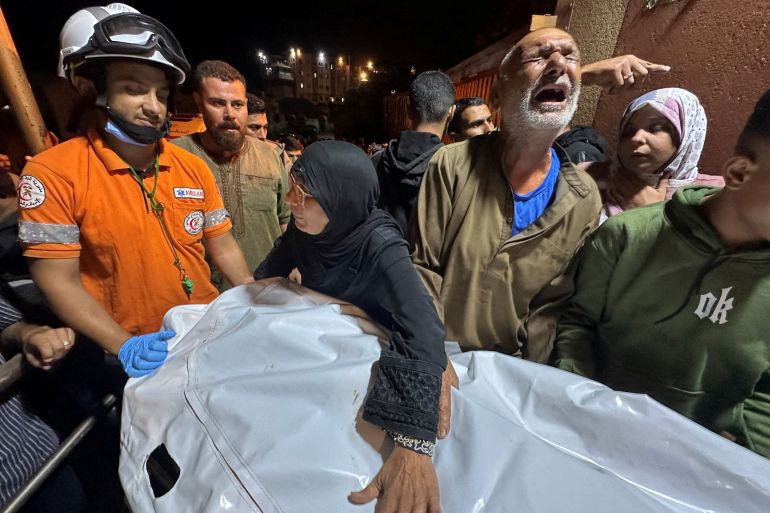Hamas hands over two bodies after Israel resumes attacks on Gaza
Office of Israeli Prime Minister Benjamin Netanyahu said the two bodies had been received by Israel.

By Al Jazeera and News Agencies
Published On 30 Oct 202530 Oct 2025
Save
The Palestinian group Hamas has handed over two bodies it said were of deceased Israeli captives, a day after the fragile Gaza ceasefire was shattered by a series of deadly Israeli strikes across the besieged enclave.
The office of Israeli Prime Minister Benjamin Netanyahu said on Thursday that the two bodies had been received by Israeli forces via the Red Cross in Gaza and would be transported into Israel for identification.
Recommended Stories
list of 3 itemsend of list
Under the US-brokered accord to halt Israel’s two-year war on Gaza, Hamas released 20 living captives in exchange for Israel releasing nearly 2,000 Palestinian political prisoners. Israeli forces have also completed a partial withdrawal from urban centres in Gaza.
But since the ceasefire took effect on October 10, Israeli attacks have killed dozens of Palestinians across the enclave. From Tuesday into Wednesday, the Health Ministry in Gaza said Israeli attacks killed 104 people, including 46 children and 20 women.
As part of the agreement, Hamas committed to returning the remains of all 28 captives, in exchange for the bodies of Palestinians killed in the war. By Thursday, it had handed over 15 sets of remains, saying it continues to press for proper equipment and support to comb through vast mounds of rubble and debris — where thousands of Palestinians killed in Israeli bombardments are still buried.
Israel claims Hamas has been too slow to hand over the remaining bodies of Israeli captives still in Gaza.
Reporting from az-Zuwayda in central Gaza, Al Jazeera’s Tareq Abu Azzoum said Hamas is still facing “logistical and operational challenges regarding the retrieval of the bodies, specifically in areas that have been impacted by the Israeli bombardment”.
Advertisement
“Hamas has been calling for the entry of heavy bulldozers and machines in order to facilitate the process of recovering bodies. But on the ground, Israel is still accusing Hamas of deliberately procrastinating the release of the bodies,” Abu Azzoum said.
The dispute over the recovery and handover of bodies has been one of the difficulties complicating US President Donald Trump’s plan to end the war for good.
Numerous major obstacles still lie ahead, including the future administration of Gaza and the demand for Hamas to disarm.
‘Essential role of NGOs’
Earlier, witnesses said Israeli planes carried out 10 air strikes in areas east of Khan Younis in the southern Gaza Strip, and tanks shelled areas east of Gaza City in the north before dawn.
The Israeli military said it carried out “precise” strikes against “terrorist infrastructure that posed a threat to the troops” in the areas of Gaza where its forces are still present.
Meanwhile, a UN official said more than 24,000 tonnes of UN aid have reached Gaza since the start of a ceasefire, while calling for NGOs to be allowed to assist in its distribution.
While aid volumes are significantly up compared with the period before the ceasefire, humanitarians still face funding shortfalls, the UN says, as well as issues coordinating with Israeli authorities, which are continuing to seal vital border crossings.
The World Food Programme’s Middle East Regional Director Samer Abdel Jaber said in 20 days of scale-up following the ceasefire, they “have collected about 20,000 metric tons of food inside Gaza”.
“The implementation of the 20-point [ceasefire] plan remains to be the central point and the central condition for us to be able to deliver humanitarian assistance in a holistic manner,” Alakbarov said.
He called on Israel to allow more NGOs to participate in the delivery of aid in Gaza, which Israel has banned.
“The persisting issue of registration of NGOs remains to be a bottleneck issue. We continue to emphasise the essential role of NGOs and national NGOs, which they play in humanitarian operations in Gaza, and we have escalated this now,” he said.
Israel’s assault has displaced most of Gaza’s more than two million people, many of them several times. The majority haven’t yet returned to their ravaged neighbourhoods, fearing they could soon be displaced once again or killed by Israeli forces.
Sources told Al Jazeera that the Israeli army carried out home demolitions east of the Tuffah and Shujayea neighbourhoods in eastern Gaza City on Thursday.
Advertisement
Israel has been demolishing homes since the start of its renewed ground incursion in the area earlier this month, part of what residents describe as a systematic campaign to clear large swaths of residential blocks.
Entire streets have been levelled, with bulldozers flattening homes and infrastructure as Israeli forces push deeper into Gaza City’s eastern districts.

